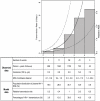Estimating the impact of plasma HIV-1 RNA reductions on heterosexual HIV-1 transmission risk
- PMID: 20856886
- PMCID: PMC2938354
- DOI: 10.1371/journal.pone.0012598
Estimating the impact of plasma HIV-1 RNA reductions on heterosexual HIV-1 transmission risk
Abstract
Background: The risk of sexual transmission of HIV-1 is strongly associated with the level of HIV-1 RNA in plasma making reduction in HIV-1 plasma levels an important target for HIV-1 prevention interventions. A quantitative understanding of the relationship of plasma HIV-1 RNA and HIV-1 transmission risk could help predict the impact of candidate HIV-1 prevention interventions that operate by reducing plasma HIV-1 levels, such as antiretroviral therapy (ART), therapeutic vaccines, and other non-ART interventions.
Methodology/principal findings: We use prospective data collected from 2004 to 2008 in East and Southern African HIV-1 serodiscordant couples to model the relationship of plasma HIV-1 RNA levels and heterosexual transmission risk with confirmation of HIV-1 transmission events by HIV-1 sequencing. The model is based on follow-up of 3381 HIV-1 serodiscordant couples over 5017 person-years encompassing 108 genetically-linked HIV-1 transmission events. HIV-1 transmission risk was 2.27 per 100 person-years with a log-linear relationship to log(10) plasma HIV-1 RNA. The model predicts that a decrease in average plasma HIV-1 RNA of 0.74 log(10) copies/mL (95% CI 0.60 to 0.97) reduces heterosexual transmission risk by 50%, regardless of the average starting plasma HIV-1 level in the population and independent of other HIV-1-related population characteristics. In a simulated population with a similar plasma HIV-1 RNA distribution the model estimates that 90% of overall HIV-1 infections averted by a 0.74 copies/mL reduction in plasma HIV-1 RNA could be achieved by targeting this reduction to the 58% of the cohort with plasma HIV-1 levels ≥4 log(10) copies/mL.
Conclusions/significance: This log-linear model of plasma HIV-1 levels and risk of sexual HIV-1 transmission may help estimate the impact on HIV-1 transmission and infections averted from candidate interventions that reduce plasma HIV-1 RNA levels.
Conflict of interest statement
Figures

References
-
- Quinn TC, Wawer MJ, Sewankambo N, Serwadda D, Li C, et al. Viral load and heterosexual transmission of human immunodeficiency virus type 1. Rakai Project Study Group. N Engl J Med. 2000;342:921–929. - PubMed
-
- Granich RM, Gilks CF, Dye C, De Cock KM, Williams BG. Universal voluntary HIV testing with immediate antiretroviral therapy as a strategy for elimination of HIV transmission: a mathematical model. Lancet. 2009;373:48–57. - PubMed
-
- Gurunathan S, Habib RE, Baglyos L, Meric C, Plotkin S, et al. Use of predictive markers of HIV disease progression in vaccine trials. Vaccine. 2009;27:1997–2015. - PubMed
Publication types
MeSH terms
Substances
Grants and funding
LinkOut - more resources
Full Text Sources
Medical

